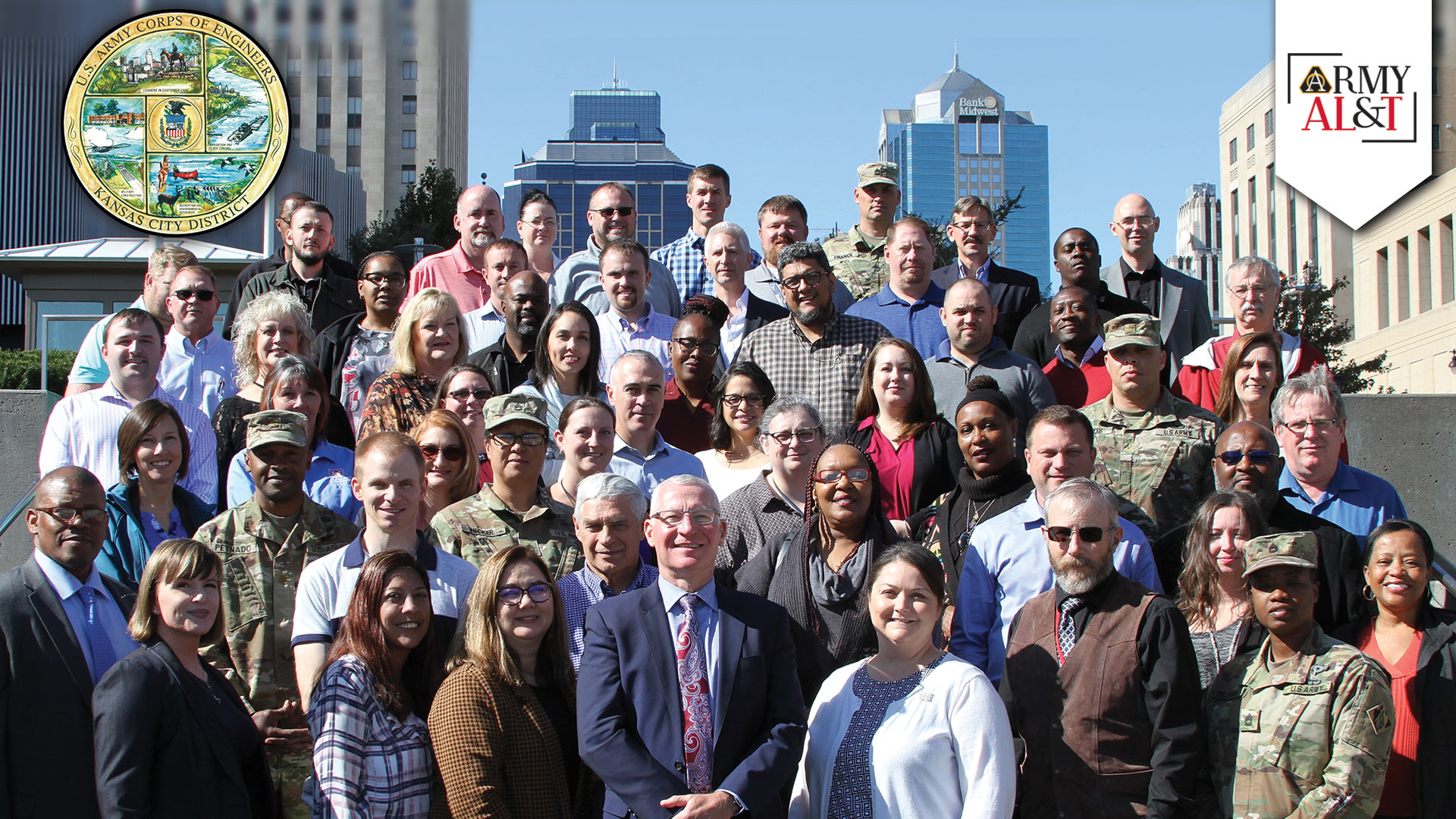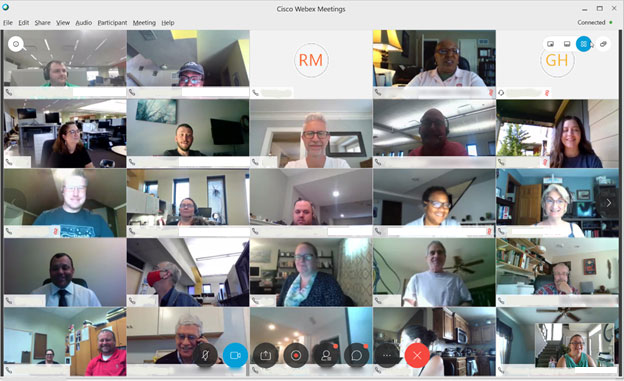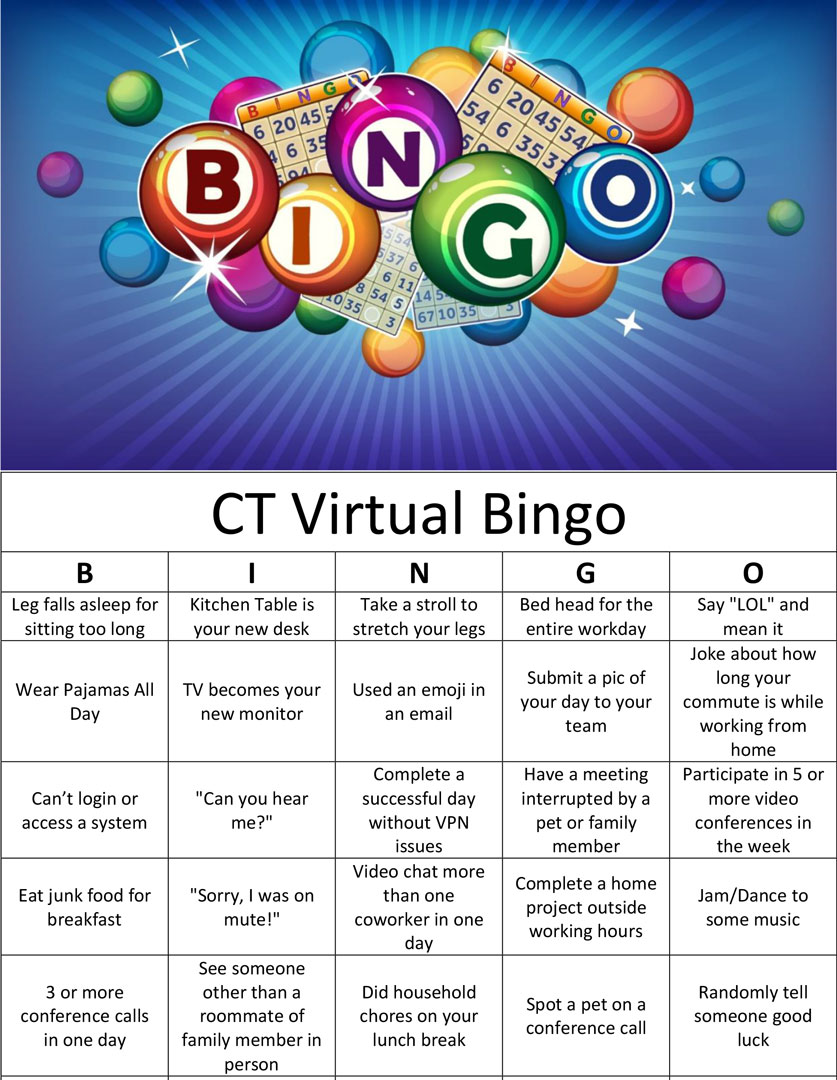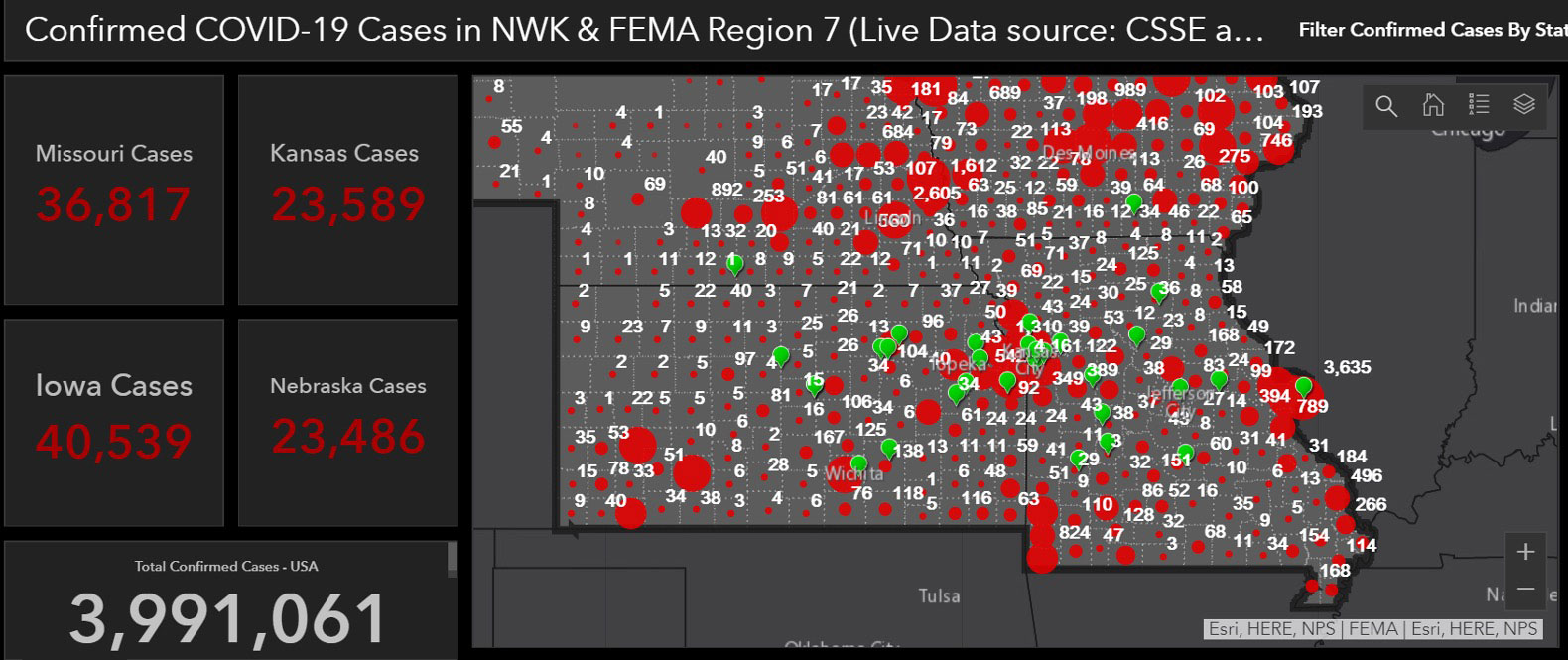
THE DIVISION: The Kansas City District Contracting Division is pictured with then-Deputy Assistant Secretary of the Army for Procurement Stuart Hazlett, outside of the Bolling Federal Building in downtown Kansas City, Missouri, on October 22, 2019. (Photo by John “Rusty” Thomas)
USACE made employee welfare its top priority during the pandemic
by Gwendolyn L. Miller and Dr. Tiffanie A. Nichols
A year ago, no one could have predicted an almost 100 percent virtual work environment throughout the world because of a pandemic. Every aspect of daily life has been impacted—schooling of children, caring for elderly relatives and shopping for household essentials—with little exception. Michael Dolly, from the U.S. Army Corps of Engineers (USACE) Kansas City District Contracting Office, expressed his disbelief, stating “Having two young kids, I was certainly shocked when our school district decided to close schools this past spring due to the COVID-19 pandemic,” he said. “At first, I was worried because I wasn’t sure how my family would be able to continue our children’s education for the rest of the school year while I continued to work full time.”
Two overarching questions guided our response to these events: What do leaders do when their traditional organization is faced with a completely virtual working environment? More importantly, how do you holistically support your staff in a time of such uncertainty and fear? Tackling these questions allowed us to view the problem from multiple angles, with the ultimate goal of meeting the mission while ensuring the safety of our workforce. We undertook several initiatives in response to these questions, including establishing a Morale Committee to engage with our workforce in an authentic and connected manner, forming the Welcome Wagon for additional support with onboarding new employees, holding weekly Chief of Contracting Office town hall events, and providing logistics support to support work schedule flexibility, equipment for home use and connectivity.

ALL TOGETHER NOW: Employees from the Kansas City District USACE participate in virtual town hall this past July. Events like this helped facilitate better communication and upheld morale for the district. (Image courtesy of Gwendolyn Miller)
WE’RE IN THIS TOGETHER
One of the greatest concerns of USACE leaders, while moving to a completely virtual environment, was the possibility of a disjointed and disconnected team. In a recent article in Chief Executive, “Maintaining Your Team’s Morale and Productivity During Covid-19,” Denise Graziano asserts that one way to increase morale during uncertain times is to let the team control organization initiatives. To this end, the Contracting Division established two working groups, made up of non-supervisors, to tackle the issue of maintaining and increasing morale: the Morale Committee and the Welcome Wagon. Contracting Division leaders also enlisted the help of a leadership coach to ensure our actions were deliberate, well thought out and considered the safety and well-being of our team members—our No. 1 priority.
Morale Committee member Stephanie Kretzer said the committee “is a great way to keep people engaged while they’re at home and sometimes isolated by themselves.” Employees, who for years had enjoyed breakfast together or met for informal breaks over coffee, were no longer able to do so. So the committee set out to develop virtual events to engage the team in fun activities, meant to offset the lack of in-person interactions that normally occur in the office. The first activity was a challenge for staff to submit pictures of their most entertaining telework attire. Interactive bingo was next, and then several employees participated in a home scavenger hunt. The committee received feedback that these activities were a little time consuming, so they began a weekly trivia contest. Winners received gift cards from local small businesses, to help support the economy while incentivizing employee participation.
Each week, we saw more and more employees participating and communicating with each other. A key member of the Morale Committee, Gary Rizzolo, said “I think the most successful part of the morale committee is it gives people opportunity to interact with other personnel.” These interactions would not occur without the proactive engagement and dedication of the committee members. In the end, it was refreshing to see the smiles and positive interactions that came from these activities. The committee continues to seek feedback and make adjustments to the activities, to ensure employees have an outlet to reduce stress and interact with their coworkers on an informal basis.
ROLL OUT THE RED CARPET
Recruitment and on-boarding did not stop as a result of the pandemic, which has created the challenge of integrating new employees into the team in a virtual environment. None of our new employees had ever worked for USACE and most were summer hires or recent graduates being introduced to the federal government and the Army. While supervisors were actively reaching out to complete the normal on-boarding requirements, we quickly discovered that integration with the rest of the team was sorely lacking. The Welcome Wagon was established with the express purpose of bridging the normal integration process that new employees experience in the traditional work environment.Leaders intentionally selected a diverse team so that different levels and types of experiences were represented. In particular, people who had been with the organization less than a year were included, since they had the most recent onboarding experience and would better relate to the new employees. Roy Maurer, with the Society for Human Resource Management, reminds managers that onboarding is much more than completing paperwork or a one-time introduction to the organization in his article “Virtual Onboarding of Remote Workers More Important Than Ever.” Maurer said true onboarding sets the stage for the new employee’s success and happiness, and that includes establishing relationships and a sense of belonging. One of the contracting office’s newest employees, Geoffrey Gould, provided feedback on his experience with the Welcome Wagon. “I especially like the interaction with other teams [and] branches, so that we got a better insight in what they do, which allowed me to better understand my role in carrying out the agency’s mission.”

WE HAVE A WINNER: The Morale Committee organized several events to help employees stay connected during the pandemic, like virtual bingo. (Image courtesy of the Moral Committee, KCDC)
Meeting weekly in group settings, the Welcome Wagon ensured employees had an additional resource other than their supervisor to reach out to, something that under normal circumstances would naturally occur. Each Welcome Wagon member also participated in multiple one-on-one sessions with the new employees, providing contracting and district resources, such as training, handouts, contacts and advice on how to be successful within their contracting role. This allowed new members to further integrate within contracting, and provided another resource for them to ask questions and seek further knowledge from more seasoned employees.
In particular, the Welcome Wagon has received positive feedback on these introductory meetings. During these WebEx calls, the employees within the contracting division would each briefly activate their camera to introduce themselves, give a little background and advise how they may be helpful to the new employees in the future. Welcome Wagon member Thomas Beyer said, “We made sure that new employees were engaged with us outside of the normal channels of their workload.” Thomas also spoke to the new employees about expectations and empathized with their feelings as new employees working virtually. Additionally, Thomas worked with the district training coordinator to develop and provide a full training packet along with helpful documents and how-to files that he distributed to the new employees. Since the Welcome Wagon’s inception in April, the committee has sought and incorporated several rounds of feedback from various new hires into the processes.
A NEW NORMAL
In “Linking Crisis Management and Leadership Competencies: The Role of Human Resource Development,” authors Lynn Perry Wooten and Erika Hayes James outline the five stages of a crisis. They are signal detection, preparation and prevention, damage control and containment, business recovery, and reflection and learning. The steps undertaken by district leaders intuitively followed the theory established within this framework and offered insight into future contingency planning. Within this framework, business recovery was imperative because the Kansas City District’s purpose is to solve some of the nation’s toughest challenges. We support critical infrastructure, military installations and recreational areas throughout our area of operations, including Kansas and Missouri, as well as portions of Colorado, Iowa and Nebraska. While the organization quickly adjusted to the new normal of virtual life, addressing the various challenges (distribution of bandwidth, connectivity issues, hardware failures, etc.), leadership was looking ahead. The main concern for the entire organization: How do we maintain employee engagement, avoid burnout and prepare for the eventual return to our offices?
The first focus for leadership was to establish town halls with the Chief of Contracting Office and its 66 employees. Within the contracting organization, there are five different branches, encompassing a multitude of acquisition job series, such as purchasing agents, procurement technicians, contracting specialists, and procurement analysts. The division also includes a military contingency contracting team of several active duty 51C professionals. The town hall meetings served multiple purposes: disseminate critical information, share good news and establish the baseline that everyone is in this situation together. Perhaps more importantly, District Contracting Chief (and co-author) Gwendolyn Miller attempted to normalize the situation that many families were now experiencing.
Embracing this format, leaders successfully modeled communication tools that were not a normal part of daily work life. An article in the Nature Human Behavior journal from May 2020, “Using Social and Behavioral Science to Support COVID-19 Pandemic Response,” by Jay J. Van Bavel et al., notes that people prefer leaders who promote a sense of togetherness rather than individualism. Additionally, they prefer leaders to communicate their expectations and their trust in their subordinates, which enables greater success during times of pandemics. This article reinforced that the actions undertaken for communication within the organization were appropriate and relevant.

INFORMATION UPDATE: As part of the weekly Town Hall meetings, Gwendolyn Miller, the district chief of Contracting, shares up-to-date information on the number of COVID-19 cases in the district’s area of responsibility.
The town hall meetings were held twice a week for about 30 minutes each during the initial transition to a virtual work environment. They were always conducted in a WebEx interactive video format, and even though participation via video was not mandatory for the team members, about half of the office chose to share their video streams during each meeting. The face-to-face visual allowed for a better sense of connection while physically separated. During these calls, Miller would also share her personal experiences, such as supporting local small businesses through curbside meal programs, gardening tips and family activity recommendations.
When the initial chaos of transitioning to a new normal had calmed, leadership let the team recommend how often to hold the meetings, resulting in a reduction to once a week. This decision was based on a decrease in angst among the employees, the completed transition to the virtual work environment and feedback received from the team members. The face-to-face format allowed the entire organization to see each other facing the same work-life balance challenges while working from home during a quarantine.
ROLL WITH THE PUNCHES
Given the almost complete shutdown of businesses and schools, it was imperative that we understand how to support individuals who could not work their traditional schedule because of new life challenges. For the first time, many schools conducted classes virtually, daycare centers were closed and some individuals became fulltime caretakers.
The solution to this problem was instituting a new working schedule that allowed maximum flexibility in performing daily work requirements. This maxi-flex schedule permitted employees to work anytime between 4 a.m. and midnight, Monday through Saturday, with additional flexibilities to work up to 10 and a half hours in a day, and a maximum of 60 hours in a week. This not only accommodated the changing personal needs of our workforce during the crisis, but also allowed for mission execution to continue through difficulties with distribution of virtual private network (VPN) bandwidth.
Employee Joan Clarkston said, “I have loved maxi-flex. Being everyone is home right now, there are some moments that are quieter than others and it has allowed me maximize those opportunities to give the job my best. Also with social distancing, it has provided me the necessary flexibility to run to the store when it isn’t as busy. Normally, I would have to take leave to do it during a regular work day.” Other employees have reported that taking advantage of the maxi-flex schedule has allowed them to care for sick family members and adjust their work hours to meet competing personal priorities.
This has ensured timely mission success without sacrificing quality, while also supporting employees’ complex personal responsibilities. “I have been able to achieve a better work-life balance than ever before, resulting in less stress and more productivity,” Michael Dolly said. “Also, knowing that my organization’s leadership has confidence in me to manage my time appropriately and responsibly adds to my overall job satisfaction.”
Secondary logistical concerns were centered on equipment and accessibility. With entire family units now working and attending school from home, personally owned equipment previously used for situational telework, such as a monitor or keyboard, was now being shared among multiple family members. Without the additional equipment, employees expressed concern for prioritizing mission essential deadlines while also ensuring their family members were able to meet their work and school commitments. The contracting organization used the principles and tenets of the Army Command Supply Discipline Program to maintain control of government property while providing the necessary resources to the employees.
We took stock of our inventory and allocated monitors and docking stations to our people, allowing our staff to quickly set up home offices for a more seamless transition to a virtual work environment and freeing up personal equipment to be used by other family members. Contracting leadership successfully mitigated the logistical stress that accompanied the unprecedented demands of employees now forced to conduct both their professional and family daily activities from home. Positive feedback in response to this simple action was shared with senior leaders, who quickly implemented the practice within the other divisions of the district as well.
CONCLUSION
Leadership researchers Arjen Boin, Paul ‘t Hart, Allan McConnell and Thomas Preston discuss the importance of leadership both during and after crisis events in their paper “Leadership Style, Crisis Response and Blame Management: the Case of Hurricane Katrina.” They write that one of the key tasks for leadership in the recovery process is to re-establish a sense of normalcy. With an event as life-altering as the COVID-19 pandemic, we should all expect a new normal to emerge. Perhaps this means increased telework or virtual employment, having systems at the ready to accommodate a sudden surge in capacity requirements or other technical needs.
For the Kansas City District Contracting Division, the new normal will be impacted by the lessons we have learned about people. Engaging in transparent and frequent communication, ensuring a proactive approach to morale and empowering employees to positively contribute to their work environment will all be enduring changes that we take from this otherwise taxing experience. One of the newest USACE contracting employees, Nichole Anderson, said, “Joining any team during this pandemic can cause any new employee to have additional stresses. You worry if you will be able to fully integrate or get the support and questions answered that you might need while working primarily away from the office as you begin. The contracting organization, through initiatives like the Welcome Wagon, has relieved any such worries for me because it has given me an opportunity to talk over any issues and to fully form relationships that have greatly helped to introduce me to my new role.” In the end, we will be a better organization, one that has proven to be agile and effective even in the most challenging of environments. We will take these lessons and prepare for tomorrow, ensuring that we are a stronger, more cohesive team that can be depended on to respond to any threat.
For more information, please see the district website at nwk.usace.army.mil. The Kansas City District Contracting Office is always looking for exceptional contracting and acquisition professionals to join our team. If interested, please email us at: kc.contracting.career@usace.army.mil
GWENDOLYN L. MILLER is the Kansas City District chief of the Contracting Office, USACE. She has been with the district for four years and with DOD contracting for over 18 years. She has a B.A. in political science from the University of Central Arkansas, is Level III certified in contracting, and is a member of the U.S. Army Acquisition Corps.
DR. TIFFANIE A. NICHOLS is a procurement analyst with the Kansas City District, USACE. She has a Ph.D. in organization and management from Capella University and is Level III certified in contracting. She has been with Army contracting for over 11 years, and is a member of the U.S. Army Acquisition Corps.
Read the full article in the Fall 2020 issue of Army AL&T magazine.
Subscribe to Army AL&T News – the premier online news source for the Army Acquisition Workforce. ![]() Subscribe
Subscribe







